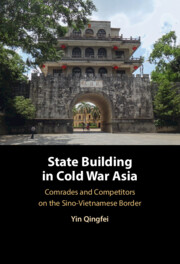Book contents
- Frontmatter
- Contents
- Figures
- Maps
- Acknowledgments
- Notes on Romanization, Names, and Pseudonymization
- Abbreviations
- Introduction
- 1 Asymmetric State Building (1949–1954)
- 2 Joint State Building (1954–1957)
- 3 Negotiated State Building (1958–1964)
- 4 Thwarted State Building on the Sea (1954–1964)
- 5 Reversed State Building (1965–1975)
- Conclusion
- Bibliography
- Index
2 - Joint State Building (1954–1957)
Published online by Cambridge University Press: 18 December 2024
- Frontmatter
- Contents
- Figures
- Maps
- Acknowledgments
- Notes on Romanization, Names, and Pseudonymization
- Abbreviations
- Introduction
- 1 Asymmetric State Building (1949–1954)
- 2 Joint State Building (1954–1957)
- 3 Negotiated State Building (1958–1964)
- 4 Thwarted State Building on the Sea (1954–1964)
- 5 Reversed State Building (1965–1975)
- Conclusion
- Bibliography
- Index
Summary
This chapter analyzes the two states’ regulation of long-existing cross-border connections and their strategies to differentiate between acceptable and non-acceptable cross-border movements and to extract revenues from the acceptable ones between 1954 and 1957. The Chinese and Vietnamese communists pursued two interrelated goals at the territorial limits of their countries. First, they wanted to build an inward-oriented economy and society at their respective borders by consolidating the national administration of territory. Second, they sought to impose a contrived Cold War “comradeship” between the PRC and the DRV over and in place of the organic interdependence of peoples within the borderlands that had already existed for centuries. The Sino-Vietnamese border, therefore, encountered “joint state building” by the two communist governments, which made the cross-border movement of people and goods more visible, malleable, and, more importantly, taxable to the state. The pursuit of both national and international communist goals by central governments, however, often left the local state apparatus, which bore the burden of implementing these policies, confused and bogged down by conflicting priorities. Moreover, the culturally diverse and fluid on-the-ground realities of the borderlands did not fit easily into the nationalist or internationalist agenda of the two states.
Keywords
- Type
- Chapter
- Information
- State Building in Cold War AsiaComrades and Competitors on the Sino-Vietnamese Border, pp. 76 - 117Publisher: Cambridge University PressPrint publication year: 2024

